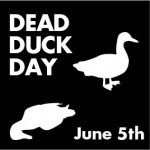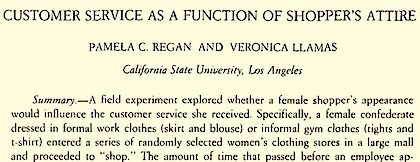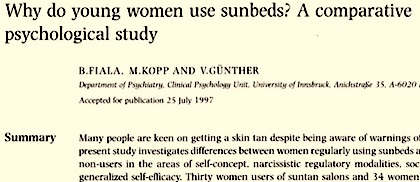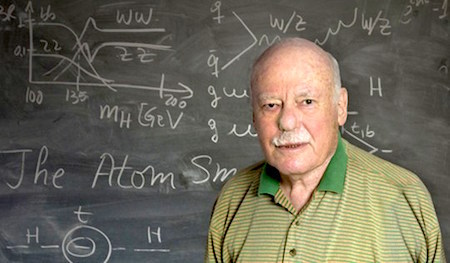Marc Abrahams's Blog, page 289
January 1, 2016
A look back at the 20th Dead Duck Day
 It took some time to write-up the things that happened at the 20th edition of Dead Duck Day — commemorating the first scientifically documented case of homosexual necrophilia in the mallard duck. Here it is, laced with photographs:
It took some time to write-up the things that happened at the 20th edition of Dead Duck Day — commemorating the first scientifically documented case of homosexual necrophilia in the mallard duck. Here it is, laced with photographs:
On June 5th, 2015, the 20th Dead Duck Day attracted a crowd of about 50 people. They gathered at the spot where it all began, right below the all glass facade of the Natural History Museum Rotterdam. At exactly 17:55h Kees Moeliker, in company of the stuffed duck (NMR 9989-00232), welcomed everybody … [Read the entire write-up here]
The 21st Dead Duck Day will be on Sunday, June 5th 2016, and – as usual – will include a meal.


December 31, 2015
Ball squeezing for enhanced creativity (update)
 Some say that squeezing balls can enhance one’s creativity. [for background see: from 2010, Improbable article : ‘Ball squeezing and creativity’] Questions can arise however – such as ‘what kind of balls might work best’ and ‘under what circumstances’? Answers may depend on the kind of creative task in hand, as is postulated in a new paper from JongHan Kim, who is an assistant professor of psychology at Coastal Carolina University, US. See: ‘Physical Activity Benefits Creativity: Squeezing a Ball for Enhancing Creativity’ (Creativity Research Journal, Volume 27, Issue 4, 2015)
Some say that squeezing balls can enhance one’s creativity. [for background see: from 2010, Improbable article : ‘Ball squeezing and creativity’] Questions can arise however – such as ‘what kind of balls might work best’ and ‘under what circumstances’? Answers may depend on the kind of creative task in hand, as is postulated in a new paper from JongHan Kim, who is an assistant professor of psychology at Coastal Carolina University, US. See: ‘Physical Activity Benefits Creativity: Squeezing a Ball for Enhancing Creativity’ (Creativity Research Journal, Volume 27, Issue 4, 2015)
“Studies in embodied cognition show that physical sensations, such as touch and movement, influence cognitive processes. Two studies were conducted to test whether squeezing a soft versus a hard ball facilitates different types of creativity. Squeezing a malleable ball would increase divergent creativity by catalyzing multiple or alternative ideas, whereas squeezing a hard ball would increase convergent creativity by facilitating only a single correct response. In Study 1, participants squeezed either a hard ball or a soft ball while completing the Torrance Test of Creative Thinking (TTCT), a divergent creativity test. The same procedures were used in Study 2 except that the TTCT was replaced with the Remote Associates Test, a convergent creativity test. Participants who squeezed a soft ball generated more original and diverse ideas (Study 1), whereas participants who squeezed a hard ball were better at coming up with a single correct answer (Study 2).”
Note: The squeeze-ball shown in the photo, which is soft, is professor Verna Gillis’s Kick Butt™ ball – profiled here.

December 30, 2015
Podcast #44: Stool pigeons, and clothes-shopping clothes, and tanning beds
Stool pigeons, clothing-shopping clothing, and the dark attitudes of people who tan themselves in tanning beds — these are the things that turn up in this week’s Improbable Research podcast.
SUBSCRIBE on Play.it, iTunes, or Spotify to get a new episode every week, free.
This week, Marc Abrahams —with dramatic readings by Jean Berko Gleason — tells about:
Self-control by pigeons. (“Self-Control by Pigeons in the Prisoner’s Dilemma,” Forest Baker and Howard Rachlin, Psychonomic Bulletin and Review, vol. 9, no. 3, September 2002, pp. 482-8.

Clothing to wear when you go shopping for clothing. “Customer Service as a Function of Shopper’s Attire,” Pamela C. Regan and Veronica Llamas, Psychological Reports, vol. 90, no. 1, February 2002, pp. 203-4.

The dark, anti-people attitudes of people who use tanning beds. “Why Do Young Women Use Sunbeds? A Comparative Psychological Study,” B. Fiala, M. Kopp, and V. Gunther, British Journal of Dermatology, vol. 137, no. 6, December 1997, pp. 950-4.

The mysterious John Schedler or the shadowy Bruce Petschek perhaps did the sound engineering this week.
The Improbable Research podcast is all about research that makes people LAUGH, then THINK — real research, about anything and everything, from everywhere —research that may be good or bad, important or trivial, valuable or worthless. CBS distributes it, on the CBS Play.it web site, and on iTunes and Spotify).

December 29, 2015
Drink | drunk | hungover (studies)
 Scenario: You’re on holiday. You drink heavily. What are the factors that might contribute towards a hangover? Such a question was asked by researchers Morten Hesse and Sébastien Tutenges of the University of Aarhus, Centre for Alcohol and Drug Research, Copenhagen Division, Denmark, who performed a 2010 observational prospective study with a total of 112 young Danish tourists. They were interviewed on three occasions during their holiday, and completed the Acute Hangover Scale (AHS) – answering questions about their alcohol consumption and rest duration. The results:
Scenario: You’re on holiday. You drink heavily. What are the factors that might contribute towards a hangover? Such a question was asked by researchers Morten Hesse and Sébastien Tutenges of the University of Aarhus, Centre for Alcohol and Drug Research, Copenhagen Division, Denmark, who performed a 2010 observational prospective study with a total of 112 young Danish tourists. They were interviewed on three occasions during their holiday, and completed the Acute Hangover Scale (AHS) – answering questions about their alcohol consumption and rest duration. The results:
“Hangovers after heavy drinking during holidays appear to be related both to amount drunk and time into the holiday.”
see: ‘Predictors of hangover during a week of heavy drinking on holiday’ in: Addiction, Volume 105, Issue 3, pages 476–483, March 2010.
In a broadly similar vein, a new (Dec. 2015) paper from professor Tutenges examines ‘Pub crawls at a Bulgarian nightlife resort: A case study using crowd theory’ in: Tourist Studies, vol. 15, no. 3, pp. 283-299.
“Drawing on the classical crowd theories of Tarde, Le Bon, Durkheim, and Canetti, this article examines pub crawl crowds at the Bulgarian nightlife resort, Sunny Beach. The article argues that there are elements in classical crowd theory which can be used to advance the current research on tourist crowds such as those at pub crawls.“ [our hyperlink]
Note: The photo is part of a montage by professor Tutenges entitled ‘Designing Drunkenness’ a presentation for Club Health 2013.

December 28, 2015
Sad News: Harry Lipkin is gone
I’m very sorry to report that Harry Lipkin has died. Harry was a founding editorial board member of the Annals of Improbable Research, and long before that — in 1955, he and Alex Kohn co-founded the Journal of Irreproducible Results, the forerunner of the Annals. Harry was also, by the way, one of the world’s great physicists. For most of his life he was a professor at the Weizmann Institute.
Harry died in September, just a few days before the 25th First Annual Ig Nobel Prize ceremony. Harry and Alex had devised the basic idea of the Ig Nobel Prize many years earlier, and both of them helped me, from afar, found the ceremony back in 1991. Harry was almost-eternally going to come be part of the show — sadly he never quite made it. (Alex died in 1994.)
In 1994, when the then-publisher of the old magazine was going to consign it to oblivion (and it became clear that nothing any of us could do would stop them), I resigned as editor, and with help from Harry and Alex and the rest of the gang, started a brand new magazine — thus was born the Annals of Improbable Research.
Over a long span of years, Harry influenced (and was good friends with) a substantial part of the world’s top layer of physicists, and many, many other people. Here’s part of the appreciation that was published in both the CERN Courier and Physics Today:
Lipkin was born in New York City in 1921 and grew up in Rochester, New York. His life was very rich: he graduated in engineering; contributed to the crucial WWII anti U-boat microwave radar project at MIT; undertook an experimental-physics PhD thesis at Princeton; immigrated to Israel with his wife Malka to start a pioneering life in an agricultural kibbutz on the Lebanese border; was sent to France to study nuclear reactors; joined an early R&D unit of the Israeli army; co-founded and moved into the newly created Department of Nuclear Physics at the Weizmann Institute; became a theoretical nuclear physicist… and we have only reached 1955 in his history. For the remaining 60 years of his life, he also contributed to theoretical condensed-matter physics, particularly the Mössbauer effect; basic problems in quantum mechanics; and, especially, particle physics, with an emphasis on symmetries, quark-model analysis, applications of group theory and a wide variety of other topics. His book Lie Groups for Pedestrians introduced many generations of physicists to the subject. He received several major prizes, including the Wigner Medal, the Emet Prize and the Rothschild Prize. He spent long periods of research in the US, especially at Argonne National Lab and, for decades, was a frequently invited speaker at just about every major physics department and conference.
But his original contributions to physics research were only one aspect of his incredible career. He always felt that one should never take oneself too seriously, even as a scientist. Together with virologist Alexander Kohn, he founded the Journal of Irreproducible Results…
Harry was a thoughtful, funny, prolific writer. For a taste of his thoughts and his personality, read his essay “Why talking to physicists tells you what you can’t hear elsewhere“, which was published in the APS [American Physical Society] News, in 2009.
If you’re a bit more adventurous, take a read through his paper “Quantum Theory of Neutrino Oscillations for Pedestrians – Simple Answers to Confusing Questions“.

The Tay Bridge Disaster, remembered on its anniversary
Today, December 28, is the anniversary of the Tay Bridge Disaster. The tragedy is now remembered in connection with the disaster of the poem it inspired. William McGonagall (whose family name, at least, is familar to readers of the Harry Potter books, because his grave is in the cemetery near the coffee shop where the first Harry Potter book was written) wrote the poem.
We made three videos involving the poem. In this video, Dr. Elena Bodnar and Terry Jones perform a Ukrainian translation of part of the poem.To the best of our knowledge this is the first time the poem was performed, even partially, in Ukrainian:
In another video, the passengers in a train on the Tay Bridge recite the poem. To the best of our knowledge this is the first time the poem was recited by a group on a train on the bridge:
In our third video, a group of actors perform the poem together, at the Central Square Theater, Cambridge, Massachusetts USA, as part of the 2011 Cambridge Science Festival. The readers are Dafydd ap Rees, Debra Wise, Robin Abrahams, David Kessler, Ig Nobel Prize winner Patricia Priest, Daniel Rosenberg and Roberta Gilbert:
BONUS: Every March, during selected shows in the Ig Nobel Tour of the UK (for the UK’s National Science Week), we and/or the audience perform the poem. Consider yourself warned, should you be considering whether to attend these events.
BONUS: There exists a video of Billy Connelly performing the poem on a hill in Dundee, Scotland, overlooking the Tay Bridge, in a snowstorm. It is perhaps the greatest performance of the poem by anyone other than the author (McGonagall himself often was pelted with peas when he performed his poems, a fact that did not prevent him from repeatedly performing them in public).

December 27, 2015
2015 in Hair (Luxuriant Flowing Hair Club for Scientists™)
Good news for scientists and people who appreciate hair – The 2015 Members Gallery of the Luxurious Flowing Hair Club for Scientists (LFHCfS) and its conjoined clubs has been released.

D. Eric Aston, N. Okulova, Jimmy, and J. Verdolin are among the 2015 new members of the LFHCfS
Individual members are announced as they are inducted throughout the year, in the Improbable Blog (Hair Club section), and as each year closes they are collected into an annual gallery in the hair clubs’ website.
State of The Hair Clubs:
2015 was a good year for the clubs, with 23 new members from 6 countries, for a grand total of 539 members – unless someone else joins between now and New Year’s Day.
2015 also saw the number of these united hair clubs grow from 3 to 5 clubs. The complete list is now:
The Luxuriant Flowing Hair Club for Scientists™ (LFHCfS)
For scientists who have, or believe they have, luxuriant flowing hair
The Luxuriant Former Hair Club for Scientists™ (LFHCfS)
For scientists who have a luxuriant head of former hair
The Luxuriant Facial Hair Club for Scientists™ (LFHCfS)
For scientists who have luxuriant flowing facial hair
The Luxuriant Flowing, Former, or Facial Hair Club for Social Scientists™ (LFFFHCfSS)
For social scientists who have luxuriant flowing facial hair
The Luxuriant Flowing, Former, or Facial Hair Club for Science Journalists™ (LFFFHCfSJ)
For science journalists who have luxuriant flowing facial hair
Woman and Man of The Year:
Early in 2016 we will announce the hair clubs’ Woman and Man of the Year!
Suggest a Member:
Please let us know if you believe that you or someone you know qualifies to be in one (or more) of these clubs – or someone who deserves to be an Historical Honorary member.

Dr. NakaMats, continued!
Gamely defying the predictions of his doctors, Dr. NakaMats is (1) still alive, and (2) still holding press conferences. On December 25, 2015 he sent us this note, from his home in Tokyo:
Yesterday I had the press conference at the Foreign Correspondents’ Club for the following important notice:
Today is 7 days before estimated death day of Sir Dr. NakaMats of which famous Medical Doctor has predicted.
Today Sir Dr. NakaMats announced that planned 10 inventions of ten therapies to beat cancer has all completed just before 7 day of his death day!
Sir Dr. NakaMats says “I didn’t know the effectiveness of these 10 invented therapies, though I believe my theory of these invented therapy are right. The effectiveness of these inventions will be proven by the fact that Sir Dr. NakaMats will die at Dec. 31, ’15 or survive.”
Sir Dr. NakaMats announced the next press conference will be held on Jan 30, ’16.
At that time, the reporter of press conference will see either the coffin or live Sir Dr. NakaMats.
Best wishes and Merry Christmas
Sir Dr. NakaMats
BACKGROUND: The final birthday party of Dr. Nakamats
BACKGROUND: The 2005 Ig Nobel Prize for nutrition was awarded to Dr. NakaMats for photographing and retrospectively analyzing every meal he has consumed during a period of 34 years (and counting). The streak has now, in 2015, reached 44 years. Dr. NakaMats is (as most of the world well knows) famed also for his more than 3500 patented inventions, one of which is the self-defense wig. He is still, he informs us, working on new inventions.
BONUS: Improbable Research podcast #17 included an audio recording of part of Dr. NakaMats’s now-legendary train ride from Copenhagen to Stockholm.

Biblical Bone Euphemism, Perhaps
Biblical study and biology combine in this treatise:
“Congenital human baculum deficiency: The generative bone of Genesis,” Scott F. Gilbert [pictured here] and Ziony Zevit, American Journal of Medical Genetics, vol. 101, no. 3, 2001, pp. 284-285. The authors explain:
“Whereas most mammals (including common species such as dogs and mice) and most other primates (excepting spider monkeys) have a penile bone, human males lack this bone and must rely on fluid hydraulics to maintain erections. This is not an insignificant bone…. One of the creation stories in Genesis may be an explanatory myth wherein the Bible attempts to find a cause for why human males lack this particular bone. Our opinion is that Adam did not lose a rib in the creation of Eve. Any ancient Israelite (or for that matter, any American child) would be expected to know that there is an equal (and even) number of ribs in both men and women. Moreover, ribs lack any intrinsic generative capacity. We think it is far more probable that it was Adam’s baculum that was removed in order to make Eve. That would explain why human males, of all the primates and most other mammals, did not have one.”
(Thanks to investigator Ann Starr for bringing this to our attention.)

December 26, 2015
How curious is the kangaroo (and other animals)
 We’re rapidly approaching the semicentennial anniversary of the classic and yet-to-be-replicated study ‘Curiosity in Zoo Animals’ (Behaviour, Volume 26, Issue 1). Investigators Stephen E. Glickman and Richard W. Sroges* performed an extensive series of experiments with kangaroos and more than 100 other species of zoo animals, to see how curious they were. The team presented various objects (a pair of wooden blocks, two lengths of steel chain, two pieces of wooden dowel, two lengths of rubber tubing and a white crumpled paper ball) which were scaled (roughly) according to the size of the animal under test. The animals’ visual inspections of, and other interactions with, the objects were recorded (unless they were purely accidental) and scored accordingly.
We’re rapidly approaching the semicentennial anniversary of the classic and yet-to-be-replicated study ‘Curiosity in Zoo Animals’ (Behaviour, Volume 26, Issue 1). Investigators Stephen E. Glickman and Richard W. Sroges* performed an extensive series of experiments with kangaroos and more than 100 other species of zoo animals, to see how curious they were. The team presented various objects (a pair of wooden blocks, two lengths of steel chain, two pieces of wooden dowel, two lengths of rubber tubing and a white crumpled paper ball) which were scaled (roughly) according to the size of the animal under test. The animals’ visual inspections of, and other interactions with, the objects were recorded (unless they were purely accidental) and scored accordingly.
“The kangaroos were not notably reactive. No kangaroo obtained a score of greater than 6 to any objects, with the exception of the paper. The oldest male kangaroo began to devour this object and the test was discontinued after two minutes of steady chewing. The young male also chewed steadily upon the paper, although the test was completed as he made no attempts to swallow the material. Both female kangaroos showed no reaction to the paper, aside from an initial sniff in the adult subject. The youngest kangaroo (of unknown sex) grew progressively more upset as testing proceeded and we were unable to complete the last test (crumpled paper) as the animal was leaping blindly about the stall.”
Of the other species, primates were by far the most curious, whereas reptiles, as a whole, were largely indifferent – with the exception of one Orinoco crocodile “who lunged at, pushed and bit all of the test stimuli.”
A full copy of the paper may be found here.
*note: Improbable has not been able to find any online record of Richard W. Sroges, except, possibly, ‘Development of Edible Mouth Coolants’. (paperback, 1967)

Marc Abrahams's Blog
- Marc Abrahams's profile
- 14 followers




